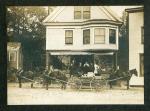Text by Lorraine Robichaud Legere
Images contributed by the Mexico Historical Society
About one month after its incorporation in 1818, the freeholders of Mexico held their first town meeting at the home of Isaac Gleason. The meeting was issued by Frances Keyes and directed by Nathan Knapp

Mexico Corner ca. 1915
Mexico Historical Society
Mexico Corner in early years was mainly a farming community with Curtis Howe operating the first general store. There was a fording place on the Swift River between Mexico and Rumford that was used when the river was low in summer and on the ice in winter. In 1901 the Red Bridge was built near this location.
Isaac Gleason was considered the pioneer of Mexico Corner. The Gleason farm, also known as The Intervale Farm, followed the contour of the Androscoggin River to just below the Goodwin Cottages. John Kidder, Virgil Haines, William Hall, and Orville P. Tucker were among others owning farms during this time period. By the late 1800's this area was known as the best farming valley in the state of Maine.

Charles Stanley Sons Market, Mexico, ca. 1900
Mexico Historical Society
Dr. Walker was the earliest educated physician, whose residence occupied the site of the Henry Parks house. Dr. Arad Farwell was another early physician, as well as Dr. Tracy. Henry W. Parks general store stood on the corner of Main Street and Roxbury Road and sold medical supplies, codfish, tea, molasses, rum, hardware, and bolts of cloth. The Bob Cat Inn and Reed Livery Stables stood across the street from the stores of Charles Stanley and Thomas Stevens. Another early settler in the village was William Whitman, the grandfather of Hosea B. Whitman. William Whitman settled where G. H. Gleason later lived.

Village Shop, Mexico, ca. 1900
Mexico Historical Society
In the census of 1880 taken by Henry W. Parks there are 12 families living in the village of Mexico including his family, Emily Putnam, Isaac Gleason, Lydia Gleason, John B. Kidder, William M. Hall, Frank G. Parsons, John Burnham, Clark Houston, David Brown, Victor Abbott, and Orville P. Tucker. After he recorded the eleventh family he wrote: "There ends the Village of Mexico Census". Then as an afterthought, he adds his family and writes: "The family of myself living in the village of Mexico Corner carless "
By 1910, many of the stores had changed owners. Hardware stores were being built to supply the building boom due to the construction of the Oxford Paper Company across the Androscoggin River in Rumford. Thus began a period of great growth and prosperity for this community.
Sources:
A Story of the Town of Mexico 1818-1968, Ruby Bragdon -Theresa Thomas
Mexico Maine by Mitchell
Mexico; Where the Early Families Lived by Doris G. Philbrick
1880 United Stated Federal Census Record -Ancestry.com